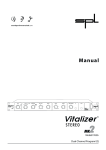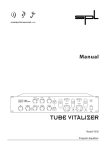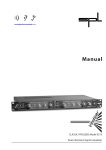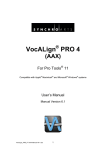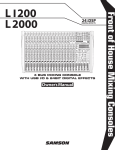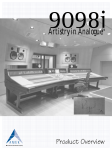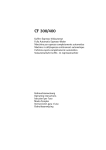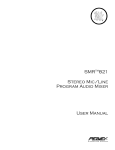Download Sound Performance Lab 9319 Stereo Equalizer User Manual
Transcript
® Owner´s Manual ® STEREO Models 9319, 9320 SOUND PERFORMANCE LABORATORY SOUND PERFORMANCE LABORATORY STEREO VITALIZER Owner´s Manual by Paul White and Hermann Gier Version 2.2/95 The information in this document has been carefully verified and is assumed to be correct. However Sound Performance Laboratory (SPL) reserves the right to modify the product described in this manual at any time. Changes without notice. This document is the property of SPL and may not be copied or reproduced in any manner, in part or full without the authorization of SPL. Limitations of Liability: In no event will SPL be liable for any damages, including loss of data, lost profits, cost of cover or other special, incidental, consequential or indirect damages arising from the use of the Vitalizer, however caused and on any theory of liability. This limitation will apply even if SPL or authorized dealer has been advised of the possibility of such damage. © 1995 SPL electronics GmbH All Rights reserved ® 1993 STEREO VITALIZER and the STEREO VITALIZER-Signet are registered trademarks of SPL electronics GmbH SPL electronics GmbH P. O. Box 12 27 D- 41368 Niederkrüchten, Germany Tel (0 21 63) 98 34-0 Fax (0 21 63) 98 34 20 EMail [email protected] www.spl-electronics.com Forword Introduction Operation safety Connections Applications Studio Tape - duplication Broadcast Sound reinforcement Video & film post production First steps The control elements of the STEREO VITALIZER VITALIZER ACTIVE PEAK BASS MID-HI TUNE PROCESS HARMONICS SURROUND PROCESSOR IN STEREO WIDTH Power supply Specifications Warranty 3 4 4 5 Contents 6 7 7 8 8 9 11 11 11 11 12 13 14 15 15 15 16 17 Dear customer, Foreword Thank you for the confidence you have shown towards SPL electronics GmbH by purchasing the SPL STEREO VITALIZER, one of the most powerful and creative signal processors currently available. The STEREO VITALIZER is a first-rate sound processor with exemplary performance, excellent workmanship and unrivalled sound quality. Please study this owner´s manual carefully so that you can make the most of the wide range of possible applications offered by the STEREO VITALIZER and to ensure ease of operation. We have tried to write this manual in such a way that it is easy to understand, with as clear a layout as the complexity of such a sophisticated product allows. The manual is divided into two columns throughout. The main column contains a detailed description whilst the margin contains headings and summarized information. We wish you every success and unlimited enjoyment with your new STEREO VITALIZER. SOUND PERFORMANCE LABORATORY SPL electronics GmbH STEREO 3 Introduction In 1993 the »Golden Ear« Award was presented to SPL by Europe´s biggest HiFimagazine »Audio«. In 1994 the »Stage Design« Award was presented to SPL by the »Artist« magazine for the exceptionally performance on stage. Operation safety Important security advices -please read them carefully! 4 The STEREO VITALIZER is an equalizer concept which makes use of scientific psychoacoustic technology to process audio signals. The unique combination of dynamic equalizers, amplitude-controlled phase correction and harmonic filtering in the STEREO VITALIZER opens up a whole new listening dimension by adapting the sound pattern to the non-linearities of the human ear. The STEREO VITALIZER gives the mid frequencies accurate transparency with a soft, unobtrusive sound. The treble and harmonics range is reworked with broadband shelving filters, which focus on achieving a smooth, silky sound pattern. High frequencies are livened up without them sounding hard or agressive. The STEREO VITALIZER uses a newly developed filter network to process the low frequency range. The bass is accentuated without any risk of emphasizing the lower mid frequencies unnaturally. You can choose between a dry, percussive bass (TIGHT) or a punchy, soft and very deep sound character (SOFT). The result is a pleasanter and livelier sound pattern with an unrivalled wealth of detail. The STEREO VITALIZER is especially designed to serve the needs in mastering, cutting and post production work. Used on complete mixes, the STEREO VITALIZER will perform the same task as those esoteric and costly equalizers often used for audio sweetening but with far greater tonal flexibility and at a much lower cost. The STEREO VITALIZER may also be teamed up with a single-ended noise reduction system to provide the ultimate, low-cost post production cleanup system for treating old masters which are often tonally dull as well as noisy. You will be amazed by how transparent and powerful almost every audio signal sounds after it has been processed with the STEREO VITALIZER! The housing of the STEREO VITALIZER has the standard 19" EIA format and occupies 1 unit (1 U = 44 mm) in your rack. When installing the unit in a 19"-rack, the rear side of the unit needs some support, especially in a touring case. The STEREO VITALIZER should not be installed near units which produce strong magnetic fields or extreme heat. Do not install the STEREO VITALIZER directly above or below power amplifiers or digital processors. If possible, the STEREO VITALIZER should be placed in an »analog rack« where the majority of (or all) the equipment installed is analog. This eliminates problems which could result from interfering high-frequency signals such as clock frequencies, MIDI or SMPTE control signals. Check that the voltage details quoted on the back panel are the same as your local mains electricity supply (Model 9320 only). Use a minus (-) screwdriver to set the voltage selector to the voltage for the area in which the unit will be used. Never cover up the ventilation slots on the top of the unit. If, during operation, the sound is interrupted or indicators no longer illuminate, or if abnormal odor or smoke is detected, or if water is spilled on the unit, immediately disconnect the power cord plug and contact your dealer or Authorized Service Center. Only clean your STEREO VITALIZER with a soft, lint-free cloth. Use only standard cleaning agents. Never use alcohol or paint thinner, because they may damage the finish. STEREO Before connecting the STEREO VITALIZER switch the power off at all connected units. Model 9320 Version 2 Model 9319 Version 1 The STEREO VITALIZER is available in two version up to autumn 1995: Version 1: unbalanced jack version (mono-1/4“ jacks wired tip hot) Version 2: professional version with unbalanced (switching mono1/4“jacks wired tip hot) and electronically balanced (3-pole XLR wired pin 2 hot) connectors. (Unbalanced connections are preferred; XLR´s may remain connected) From autumn 1995 only version 2 will be available. Connections Insert your STEREO VITALIZER into the Master-Inserts or Sub-Groups Inserts of the console! Never connet the STEREO VITALIZER between console and amplifier! Each fader movement will result in a tonal change of the STEREO VITALIZER-effect, as the input sensitivity is varied. Furthermore, impedance problems might cause additional noise. A switch on the rear panel sets the input operating level for both channels. Two positions are available: The LOW-position indicates that the input sensitivity of the STEREO VITALIZER is low, which means high level signals can be processed at this position. Conversely, the HIGH-position is used for low level signals, as the input sensitity is high. The unit may be run hotter if desired by switching the level setting from the HIGH to the LOW working level with the proviso that the PEAK LEDs on the front panel are not regularly flashing. This will achieve processing at a lower input sensitivity and will result in a more intensely processed sound. Conversely, in order to achieve milder processing, the switch may be set from LOW to HIGH. Should the need arise to use the XLR connectors in an unbalanced system, pin 3 of both the input and output connectors should be grounded. Note that unbalancing the output in this way will cause a level increase of 6dB. Follow the diagram below: The Pin assignment of the XLR-connectors is Pin 2 = hot (+). Inputs balanced Outputs unbalanced balanced unbalanced Pin wiring: 1 = Ground 2 = hot (+) 3 = cold (-) STEREO 5 Applications: Studio 1. The most obvious application of the STEREO VITALIZER is to process a final mix, either while mixing or during post-production prior to cutting. Insert your STEREO VITALIZER into the master-inserts of your console or right in between a playback and a recording unit. It is important to use full-range monitors to assess the effect of any bass processing in and out of circuit in order to appreciate just how much processing has been added; the brain soon acclimates to changes in timbre and it is easy to overdo it! If in doubt, refer frequently to known recordings played through the same monitor system. Do not connect the STEREO VITALIZER between master-outputs and amplifier. The major disadvantage of this connection is the varying input sensitivity with each fader movement. When patching the STEREO VITALIZER into the sub-groups or master-breaks of the console, note if the master breaks are switched »pre« or »post« fader. They should best be switched »pre« fader, so that a variation of the master fader does not affect the input level of the STEREO VITALIZER. The effect level and the treated sound will then remain unchanged. Application 1: The STEREO VITALIZER inserted into the Master-Inserts of the console. 2. Another popular stereo application is the processing of existing master tapes during post-production such as when reprocessing archive material for CD release. If a single-ended noise reduction system is used to clean up the original, the STEREO VITALIZER can make a significant contribution in restoring the high end detail that invariably suffers during such treatment. In many cases, the restored master can be made to sound appreciably better than the original. Application 2: The STEREO VITALIZER inserted between Noise-Reduction and Recorder to improve archived recordings. 6 STEREO In the field of electronic music, the STEREO VITALIZER can be used to add new range and depth to samplers and synthesizers and also to further process existing effects such as delay and reverberation. Even budget instruments and processors with limited audio bandwidths can be made sound full-bodied and detailed. If you want to use a compressor in the master chain after the console, use your STEREO VITALIZER after the compressor. You can then be sure that the STEREO VITALIZER will receive a level-corrected signal which helps him to even operate more precise. If you use the STEREO VITALIZER before the compressor negative side-effects such as pumping even could be emphasized. Application 3: The STEREO VITALIZER inserted between Compressor und Recorder. Tape duplication is often made at high speed resulting in a deterioration of the high frequency spectrum of the copies. By processing the output from the source machine, additional brightness can be added to compensate for deficiencies in the copying system. It may also be necessary to modify the bass end as many high speed systems fail to reproduce the bass end of the spectrum faithfully. In both areas, the STEREO VITALIZER is both effective and simple to set up. Real-time duplication is getting more and more popular. In that application the STEREO VITALIZER offers the same advantages as described under »Studio« and »Video & Film Post Production«. Tape Duplication The STEREO VITALIZER is perfectly suited to the production of radio jingles, commercials and station idents. Because of the psychoacoustic nature of the processing, the treated signal will appear louder, closer, brighter and more intelligible than whatever was played immediately beforehand, thus creating a powerful impact. In commercial radio, the STEREO VITALIZER can be used to process the entire on-air signal helping the radio station stand out from the competition. The integral surround processor can also be used to create a wider stereo spread which is important when most of the audience are listening on systems with a narrow speaker geometry such as is the case with in-car sound and portable stereo music systems. Broadcast STEREO 7 Sound Reinforcement In live performance or in club installations, the STEREO VITALIZER is a powerful ally in maintaining speech intelligibility under difficult conditions. It is also of great benefit in systems designed to play recorded music because the illusion of loudness can be maintained at lower absolute SPLs. This could be particularly beneficial with the introduction of new noise level legislation. On the subjective side, the STEREO VITALIZER helps produce a detailed, tight sound, even from indifferent speaker systems giving an improvement in perceived audio quality. The STEREO VITALIZER can be of great value when mixing under time-pressure. You can almost leave the onboard EQs flat and create the FOH sound with the STEREO VITALIZER in the master inserts. Video & Film Post Production As in other areas, the STEREO VITALIZER can be used to sharpen and enrichen dialogue, even when the microphone placement is less than optimum as is often the case when filming due to the need to keep the mic out of shot. Music soundtracks benefit in the ways already described for audioonly applications and the fact that the STEREO VITALIZER is so quick to set up can save a lot of wasted time spent tuning multi-band equalizers. Time-compressed audio can also be treated to restore the lack of timbre so often caused by such intensive processing. This is particularly valid in the case of vocal narratives as even a relatively small amount of timecompression or expansion can dramatically compromise the sound quality. On the post production work on Spike Lee´s "Malcom X" movie the voice of Denzel Washington playing Malcolm X was treated with the VITALIZER for dramatical reasons: "We wanted to make sure that there was a dramatic quality difference between the voice-over and the sync dialog," Fleischman adds, offering a mixer´s view. "You try to find a balance between two center mics then balance that with whatever you´re using from left-right pair. We then treated it with the SPL VITALIZER, a psychoacoustic equalizer. It brings a lot more presence to the upper end of the spectrum and a very deep low end so that the voice sounds full." Mix Magazine, December 1992 8 STEREO When setting up the STEREO VITALIZER for the first time, it is wise to approach the controls in a specific order to avoid confusion and to achieve positive results right from the start. Use a CD as source. First steps Set-up positions: BASS to zero (center position) HARMONICS to MIN (counter clockwise) MID-HI TUNE to 3,5 kHz (center position) PROCESS to MIN (counter clockwise) STEREO EXPANDER to min (counter clockwise) 1. Press the ACTIVE switch. There is no audible change in the sound at this stage. 2. Slowly move the PROCESS control in from the extreme left. You will find that there is no audible change in the sound until the MIN position (ca. 11 o'clock). That is just how it should be. All frequencies from 3.5 kHz (initial setting MID-HI TUNE) are only raised with increasing intensity above this point. First set the PROCESS control at 3 o'clock. The bass range is not yet influenced at this point. 3. The next step is to shift the BASS control from the zero position to both sides. Watch out for the differing bass sounds nuances. Turn to the right: The bass sounds tight and dry. Turn to the left: The bass sounds soft and round. You should perform these hearing tests on appropriate »full-range« monitors because near-field monitors normally cannot reproduce the deep bass generated by the STEREO VITALIZER in its entirety. Decide on a bass sound of the desired amplitude. 4. Now start varying MID-HI TUNE. The original setting is 3.5 kHz. Turn to the right: The programme material sounds brighter and gets more mids from about 1.5 kHz. The impression you hear is the reverse of the potentiometer scaling: the lower the frequency, the brighter and clearer sounds the programme material. This is because the MID-HI TUNE control sets a starting frequency above which all frequencies are processed. If this starting frequency is lowered, the frequency spectrum included in processing increases. The programme material then sounds brighter and clearer. Turning the control to the left shifts the starting frequency from 3.5 kHz to higher frequencies. The programme material then sounds increasingly dull, because fewer and fewer frequencies are being included in the process, the higher the frequencies become. The setting you choose is a matter of personal taste. STEREO 9 First steps 5. A section within the STEREO VITALIZER with one of the most decisive influences on the sound is PROCESS control. If you continue to turn the PROCESS control up, more of the signal is added to the BASS and MID-HI TUNE sections whilst dominant mid frequencies are reduced according human hearing at the same time. The below sections contain more detailed information on this aspect. Familiarize yourself with the sound changes before deciding on the setting which sounds best. 6. We shall now turn our attention to the HARMONICS control. Note the improved detail in the high frequency range, the further you turn the control in. In practice, values between 4 and 6 have proved to be the most common. The HARMONICS are accentuated by the STEREO VITALIZER with equalizer technology, unlike other procedures. Previously, so-called »Exciters«, devices to generate harmonic tones, produced their harmonics with the aid of a generator which mainly added type K3 and type K5 distortions to the signal (odd harmonics of 3rd and 5th order). The familiar disadvantages of this principle are as follows: although odd harmonics do add to the brilliance of the audio signal to a significant degree, they tend to be somewhat sharp, which leeds to hearing fatigue for listeners. Another pitfall is that the distortions added were not part of the original signal. The STEREO VITALIZER accentuates the harmonics which are also part of the original signal! The HARMONICS filters are designed in such a way that even and odd harmonics (K2, K3, K4, K5...) are accentuated equally. This makes the processed signal more natural with a soft, silky-sounding top-end. Once you have selected the setting for the HARMONICS control you can sit back to listen to the new sound image. 7. Finally, activate the SURROUND PROCESSOR turn up the STEREO WIDTH control to the 12h-position and note the soft spreading stereo image. 8. Switch VITALIZER ACTIVE off to return to the original signal. If you now say »I don't believe that« or »Booh«, you belong to the overwhelming majority of those people who have ever heard a VITALIZER. It was this sound impression which led to VITALIZER technology winning awards like the »Golden Ear« from Europe's biggest »Audio« magazine for the most innovative product in 1993. 10 STEREO 3 2 5 4 6 The control elements of the STEREO VITALIZER® 7 1 8 The VITALIZER ACTIVE function switches the STEREO VITALIZER on or off. The status LED indicates that the STEREO VITALIZER has been activated. The VITALIZER ACTIVE function is a relais-hard-bypass function. In the event of a power failure the STEREO VITALIZER is automatically switched to hardbypass (power failure safety). To increase the operational safety of the monitor loudspeakers you should not switch the STEREO VITALIZER on or off at high monitor volume. At high amplitudes inside the filter, there may be residual charges on the switching contacts which may be discharged when you switch over. These may become apparent as audible click sounds. If applicable, reduce or mute the monitor loudspeakers before switching on or off. 1 Vitalizer Active The input stages of the STEREO VITALIZER are equipped with PEAK LEDs which light up around 3 dB before the effect signal path is potentially overdriven. Make sure that the PEAK LEDs only light up briefly, if at all. It is essential to avoid the PEAK LEDs being lit up for any length of time. If they do so, reduce the input level or switch from LOW to HIGH on the rear of the unit. 2 Peak The BASS control is responsible for the »colour« of the bass sound your signal is to have. If you move the BASS control to the right, you get a drier, percussive bass sound, known as TIGHT. As a result of this, on the righthand side of the scaling points, there are squares which increase in size, in line with increased intensity. They symbolize the contoured »TIGHT« bass sound. If the BASS control is moved from the centre position (0) to the left, the bass sound becomes very deep, soft and warm. This sound is known as SOFT. This is symbolized with round scaling points which also increase in size as the intensity increases. The further the BASS control is shifted to the right or left of the centre position, the more intensive the bass sound in question. However, PROCESS must be positioned to the right of the MIN setting for the bass to be audible. You can always hear the original (dry) bass if the BASS control is in a centre position. 3 Bass STEREO 11 Control elements The PROCESS control determines the processing ratio between the set bass sound colour and the original signal. This results in varying bass sound structures: if you combine high bass amplification on the BASS control with a lower PROCESS value, you get a different bass structure than with a lower bass amplification combined with a higher PROCESS value. Choosing the best solution is a matter of personal taste and also depends on the type of original signal involved. Fig.1: The dotted line shows frequency responses for a soft Bass (SOFT) at maximumPROCESS and a MID-HI TUNE of 3.5 kHz. The solid line shows the phase response, which always drifts only a few degrees if the amplitude is increased. Fig. 2: The dotted line shows frequency responses for a hard Bass(TIGHT) at maximum PROCESS and a MID-HI TUNE of 3.5 kHz. The solid line shows the phase response whichhas a phase relation of -180° at 50 Hz, but otherwise also drifts only by a few degrees at increasing amplitudes. Mid-Hi Tune 12 4 The MID-HI TUNE control is used to set the starting frequency of the broad-band shelving filter. In line with the setting of PROCESS control, all frequencies above this value right through to the end of the audio range are processed. The control range of the MID-HI TUNE control is between 1 kHz (extreme right) and 20 kHz (extreme left). In practice, common settings vary between 3.5 kHz and 8 kHz. As the human ear perceives the range between 1 kHz and 3 kHz particularly clearly, at all volumes between 0 and 120 phon it makes sense to adapt this frequency range. You might feel inclined to say "Yes, but I do that with my graphic EQ as well". The main difference is that the graphic EQ really reduces the effective loudness of the frequency, i.e. cuts out the STEREO Control elements appropriate frequencies, thus changing the spectral content of the original signal. The STEREO VITALIZER , however, relies on a more subtle method of amplitude-depending phase shifting. This does not involve altering the spectral composition of the signal but it does maintain the subjective impression of loudness. Moreover, graphic equalizers produce comb-filter effects because of the interaction between adjacent filters, when broadband frequencies are raised. The MID-HI TUNE filter can raise the broadband spectrum with a very linear frequency response, without colouring the signal. Above the MID-HI TUNE value set, the STEREO VITALIZER filters create a linear increase, i.e. one that is adapted to the human ear. This compensates any inability of our hearing as regards perceiving frequencies ranging between 5 kHz and 10 kHz. The MID-HI TUNE filter works with a wide bandwidth and always sounds musical, never »bell-like«. Gradually go down from 20 kHz (extreme left) to lower frequencies. The further down you go, the brighter the sound image becomes, as an increasing number of frequencies are included in the process. The MID-HI TUNE control can also be used to tone down excessively sharp-sounding material, by setting frequencies of 10 kHz or higher, and setting the PROCESS control on MAX. Seeing as the PROCESS control is also responsible for deleting dominant mid frequencies, all frequencies are gradually reduced down to the application frequency, in conjunction with high starting frequencies of the MID-HI TUNE control. Fig. 3: Five frequency responses are shown for the MID-HI TUNE filter at max. PROCESS value and BASS at 0. 1. 1 kHz 2. 2 kHz 3. 3,5 kHz 4. 8 kHz 5. 20 kHz The PROCESS control determines the ratio between BASS and MID-HI TUNE to the original signal. The HARMONICS control is not affected by the PROCESS control. The PROCESS control also determines the damping intensity of dominant mid frequencies. This allows rapid adaptation to the loudness curves (Fletcher-Munson curves, curves of equal loudness). The human ear perceives the audio frequency spectrum at varying sound pressure levels very differently. Perception is by no means »linear«. The STEREO 5 Process 13 Control elements STEREO VITALIZER alters the frequency spectrum in such a way that the balance is maintained between all frequency ranges even at varying monitor volumes. For the human ear, the sound is more pleasant and easier to perceive than the original. In other words, increasing the PROCESS value also increases the intensity of the MID-HI TUNE filter and the BASS filter, whilst dominant mid frequencies are damped by amplitudecontrolled phase shiftings. This improves the perception of loudness, clarity and the bass punch, i.e. the strength and fullness of the audio signal. Fig. 4: The dotted line shows frequency responses for a soft Bass (SOFT) at varying PROCESS and a MID-HI TUNE of 3.5 kHz. The solid line shows the phase responses, which always drift only a few degrees if the PROCESS intensity is increased. The diagram shows very clearly that the mid attenuation gets stronger as the PROCESS value increases. Harmonics An improved harmonic structure results in a silky top-end with far better separation and intelligibility. 6 The STEREO VITALIZER works with steep filters and controlled changes of the phase relationships of the harmonics to process the harmonics structure. We consciously did without the generator principle of »Exciters«. The STEREO VITALIZER's harmonic filter does not add any distortions to the original signal, unlike with the generator principle. It extracts all the information it needs from the original signal. This significantly reduces the hearing fatigue effect on the listener. By influencing the phase relationship in an intelligent fashion, the harmonics which have been filtered out are emphasized with increasing addition expressed as a percentage. The effect significantly improves the speech intelligibility and the transparency. Old archived recordings sound fresh and silky again. The brilliance of any audio signal can be improved without it sounding sharp. The HARMONICS filter derives its input signal from the original signal and the output of the MID-HI TUNE filter. If you close the PROCESS control (extreme left), the BASS and MID-HI TUNE controls do not function any more. You can then listen to the HARMONICS control separately. The second potentiometer level of the MID-HI TUNE control is responsible for the cut-off frequency of the HARMONICS filter. A variation of the MID-HI TUNE control alters the cut-off frequency (fundamental tone) of the harmonics. Both filters complement each other in an ideal fashion as they each always process the part of the audio signal which is not being processed by the other filter. If the MID-HI TUNE control is set at 20 kHz, the HARMONICS 14 STEREO filter intervenes at low frequencies. If the MID-HI TUNE filter is at 1 kHz, the HARMONICS filter affects higher frequencies. The characteristics of the two filters therefore complement each other in an ideal fashion. The IN switch switches the SURROUND PROCESSOR on or off. The status-LED indicates, that the SURROUND PROCESSOR is activ. The IN switch works only when the VITALIZER ACTIVE switch is activated. In case you want to monitor the SURROUND PROCESSOR in isolation, switch VITALIZER ACTIVE on and set the PROCESS and HARMONICS control fully counter clockwise. 7 Surround Processor In The STEREO WIDTH potentiometer controls the stereo image. Working on estabilshed inter-channel phase principles, the STEREO WIDTH control is be used to increase the subjective soundstage width of any stereo source. The off-centre signals of the stereo source are detected and fed back to the opposite channel phase inverted. This effect can be applied to overall mixes as well as to single instruments. Very interesting is the spreading of the stereo image of overhead mics of drum-sets or choruses or horn sections. 8 Stereo Width Based around a toroidal transformer, the integral power supply is designed to minimize induced hum and noise due to the non existence of an air-gap. On the XLR/jack-version (9320) the primary voltage may be selected between 230V/50Hz and 115V/60Hz by means of a recessed slide switch on the rear panel. The jack-version is set according to local requirements. Power supply The XLR/jack-version (9320) features a rear-panel ground-lift switch which may be used where ground loops are causing hum problems. When the GND LIFT switch is set to off, the circuit ground is no longer connected to the chassis ground. The power cord connector is a 3-wire, U-ground, standard IEC mains connector for a detachable power cord (enclosed). The unbalanced jack version (9319) has a two wire power cord obviating the need of the ground lift switch. Transformer, power cord and mains connector have VDE, UL and CSA approvals. The fuse has a value of 200mA. On the secondary side of the power supply, an RC combination is used to filter out noise and hum voltages from the mains side. Both half-waves are smoothed with 2200 µF capacitors in the positive and negative voltage path. Both pathes are calibrated separately via trimmers, as deviations of only a few millivolts can result in audible changes such as a diffuse sound pattern. After the calibration stage, the current is again smoothed. STEREO 15 Specifications STEREO VITALIZER Rear Panel Version 1 (Model 9319, unbalanced jack-version, until autumn 1995) - unbalanced input & output stages (0 dB) - mono-1/4inch-jacks - 2-wire power cord - relais-hard-bypass Version 2 (Model 9320, unbal. jacks & bal. XLR-Version) - balanced (+6 dB) & unbalanced (0 dB) input & output stages - NC3 XLR-connectors and mono-1/4inch-jacks - voltage selector: 220-240 V/50 Hz or 100-120 V/60 Hz - detachable 3-wire, U-ground power cord - GND-Lift switch - relais-hard-bypass Specifications Frequency bandwidth Equalizer frequency range 10 Hz - 100 kHz (100 kHz = -3dB) 15 Hz - 22 kHz CMRR (common mode rejection) -85dBu at 100 Hz -76dBu at 1 kHz -65dBu at 15 kHz THD & N (total harmonic distortion & noise) 0,002% at 1 kHz 0,105% at 10kHz Signal to noise - CCIR 468 -96dBu Bypass: In/Effekt min: -78dBu Input & output stages XLR: instrumentation amplifier, electronically balanced (differential) transformerless nominal input level +6 dB Jack: unbalanced nominal input level 0 dB Version 1 Model 9319 Version 2 Model 9320 16 Input impedan ce (XLR, jack) Output impedance (XLR) Output impedance (jack) = 20 kOhm = 75 Ohm < 600 Ohm Input level selector LOW (0dB) / HIGH (+8dB) Peak indicators illuminate 3dB before clipping Size Standard EIA 19"/1U unit, 482 x 44 x 237mm Model 9319: 2,7kg Model 9320: 3,0kg Weight STEREO SPL electronics GmbH (hereafter called SPL) products are warranted only in the country where purchased, through the authorized SPL distributor in that country, Warranty against defects in material or workmanship. The specific period of this limited warranty shall be that which is described to the original retail purchaser by the authorized SPL dealer or distributor at the time of purchase. SPL does not, however, warrant its products against any and all defects: 1) arising out of materials or workmanship not provided or furnished by SPL, or 2) resulting from abnormal use of the product or use in violation of instructions, or 3) in products repaired or serviced by other than authorized SPL repair facilities, or 4) in products with removed or defaced serial numbers, or 5) in components or parts or products expressly warranted by another manufacturer. SPL agrees, through the applicable authorized distributor, to repair or replace defects covered by this limited warranty with parts or products of original or improved design, at its option in each respect, if the defective product is shipped prior to the end of the warranty period to the designated authorized SPL warranty repair facility in the country where purchased, or to the SPL factory in Germany, in the original packaging or a replacement supplied by SPL, with all transportation costs and full insurance paid each way by the purchaser or owner. All remedies and the measure of damages are limited to the above services. It is possible that economic loss or injury to person or property may result from the failure of the product; however, even if SPL has been advised of this possibility, this limited warranty does not cover any such consequential or incidental damages. Some states or countries do not allow the limitations or exclusion of incidental or consequential damages, so the above limitation may not apply to you. Any and all warranties, express or implied, arising by law, course of dealing, course of performance, usage of trade, or otherwise, including but not limited to implied warranties of merchantability and fitness for particular, are limited to a period of 1 (one) year from either the date of manufacture. Some states or countries do not allow limitations on how long an implied warranty lasts, so the above limitations may not apply to you. This limited warranty gives you specific legal rights, and you may also have other rights which vary from state to state, country to country. SPL electronics GmbH 41372 Niederkrüchten, Germany STEREO 17

















